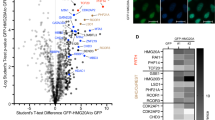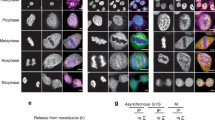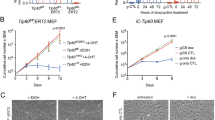Abstract
Histone acetyltransferases regulate transcription, but little is known about the role of these enzymes in developmental processes. Gcn5 (encoded by Gcn5l2) and Pcaf, mouse histone acetyltransferases, share similar sequences and enzymatic activities1. Both interact with p300 and CBP (encoded by Ep300 and Crebbp, respectively), two other histone acetyltransferases that integrate multiple signalling pathways1. Pcaf is thought to participate in many of the cellular processes regulated by p300/CBP (refs 2–8), but the functions of Gcn5 are unknown in mammalian cells. Here we show that the gene Pcaf is dispensable in mice. In contrast, Gcn5l2-null embryos die during embryogenesis. These embryos develop normally to 7.5 days post coitum (d.p.c.), but their growth is severely retarded by 8.5 d.p.c. and they fail to form dorsal mesoderm lineages, including chordamesoderm and paraxial mesoderm. Differentiation of extra-embryonic and cardiac mesoderm seems to be unaffected. Loss of the dorsal mesoderm lineages is due to a high incidence of apoptosis in the Gcn5l2 mutants that begins before the onset of morphological abnormality. Embryos null for both Gcn5l2 and Pcaf show even more severe defects, indicating that these histone acetyltransferases have overlapping functions during embryogenesis. Our studies are the first to demonstrate that specific acetyltransferases are required for cell survival and mesoderm formation during mammalian development.
This is a preview of subscription content, access via your institution
Access options
Subscribe to this journal
Receive 12 print issues and online access
$209.00 per year
only $17.42 per issue
Buy this article
- Purchase on Springer Link
- Instant access to full article PDF
Prices may be subject to local taxes which are calculated during checkout






Similar content being viewed by others
References
Xu, W., Edmondson, D.G. & Roth, S.Y. Mammalian GCN5 and P/CAF acetyltransferases have homologous amino-terminal domains important for recognition of nucleosomal substrates. Mol. Cell. Biol. 18, 5659–5669 (1998).
Blanco, J.C. et al. The histone acetylase PCAF is a nuclear receptor coactivator. Genes Dev. 12, 1638–1651 (1998).
Liu, L. et al. p53 sites acetylated in vitro by Pcaf and p300 are acetylated in vivo in response to DNA damage. Mol. Cell. Biol. 19, 1202–1209 (1999).
Puri, P.L. et al. Differential roles of p300 and PCAF acetyltransferases in muscle differentiation. Mol. Cell 1, 35–45 (1997).
Sakaguchi, K. et al. DNA damage activates p53 through a phosphorylation-acetylation cascade. Genes Dev. 12, 2831–2841 (1998).
Yang, X.J., Ogryzko, V.V., Nishikawa, J., Howard, B.H. & Nakatani, Y. A p300/CBP-associated factor that competes with the adenoviral oncoprotein E1A. Nature 382, 319–324 (1996).
Chakravarti, D. et al. A viral mechanism for inhibition of p300 and PCAF acetyltransferase activity. Cell 96, 393–403 (1999).
Hamamori, Y. et al. Regulation of histone acetyltransferases p300 and PCAF by the bHLH protein twist and adenoviral oncoprotein E1A. Cell 96, 405–413 (1999).
Herrmann, B.G. & Kispert, A. The T genes in embryogenesis. Trends Genet. 10, 280–286 (1994).
Crossley, P.H. & Martin, G.R. The mouse Fgf8 gene encodes a family of polypeptides and is expressed in regions that direct outgrowth and patterning in the developing embryo. Development 121, 439–451 (1995).
Burgess, R., Cserjesi, P., Ligon, K.L. & Olson, E.N. Paraxis: a basic helix-loop-helix protein expressed in paraxial mesoderm and developing somites. Dev. Biol. 168, 296–306 (1995).
Bettenhausen, B., Hrabe de Angelis, M., Simon, D., Guenet, J.L. & Gossler, A. Transient and restricted expression during mouse embryogenesis of Dll1, a murine gene closely related to Drosophila δ. Development 121, 2407–2418 (1995).
Echelard, Y. et al. Sonic hedgehog, a member of a family of putative signaling molecules, is implicated in the regulation of CNS polarity. Cell 75, 1417–1430 (1993).
Sasaki, H. & Hogan, B.L. Differential expression of multiple fork head related genes during gastrulation and axial pattern formation in the mouse embryo. Development 118, 47–59 (1993).
Ang, S.L. & Rossant, J. Anterior mesendoderm induces mouse Engrailed genes in explant cultures. Development 118, 139–149 (1993).
Wolf, C. et al. The M-twist gene of Mus is expressed in subsets of mesodermal cells and is closely related to the Xenopus X-twi and the Drosophila twist genes. Dev. Biol. 143, 363–373 (1991).
Ang, S.L. & Rossant, J. HNF-3 β is essential for node and notochord formation in mouse development. Cell 78, 561–574 (1994).
Edmondson, D.G., Lyons, G.E., Martin, J.F. & Olson, E.N. Mef2 gene expression marks the cardiac and skeletal muscle lineages during mouse embryogenesis. Development 120, 1251–1263 (1994).
Yao, T.P. et al. Gene dosage-dependent embryonic development and proliferation defects in mice lacking the transcriptional integrator p300. Cell 93, 361–372 (1998).
Hogan, B., Beddington, R., Costantini, F. & Lacy, E. Manipulating the Mouse Embryo: A Laboratory Manual (Cold Spring Harbor Laboratory Press, Cold Spring Harbor, 1994).
Acknowledgements
This work was supported by grants from the USARMC and the Robert A. Welch Foundation to S.Y.R. and a grant from the NIH to R.R.B.
Author information
Authors and Affiliations
Corresponding author
Rights and permissions
About this article
Cite this article
Xu, W., Edmondson, D., Evrard, Y. et al. Loss of Gcn5l2 leads to increased apoptosis and mesodermal defects during mouse development. Nat Genet 26, 229–232 (2000). https://doi.org/10.1038/79973
Received:
Accepted:
Issue Date:
DOI: https://doi.org/10.1038/79973
This article is cited by
-
Conservation and diversity of the eukaryotic SAGA coactivator complex across kingdoms
Epigenetics & Chromatin (2021)
-
HAG1 and SWI3A/B control of male germ line development in P. patens suggests conservation of epigenetic reproductive control across land plants
Plant Reproduction (2021)
-
Association between rare variants in specific functional pathways and human neural tube defects multiple subphenotypes
Neural Development (2020)
-
Dynamic modules of the coactivator SAGA in eukaryotic transcription
Experimental & Molecular Medicine (2020)
-
The many lives of KATs — detectors, integrators and modulators of the cellular environment
Nature Reviews Genetics (2019)



